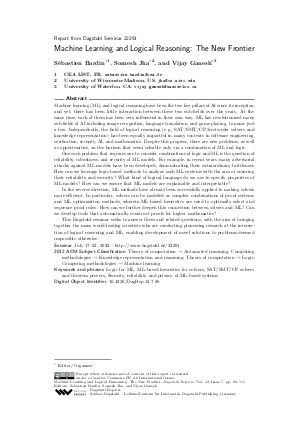Machine Learning and Logical Reasoning: The New Frontier (Dagstuhl Seminar 22291)
Authors Sébastien Bardin, Somesh Jha, Vijay Ganesh and all authors of the abstracts in this report
-
Part of:
Issue:
Dagstuhl Reports, Volume 12, Issue 7
Part of: Volume: Dagstuhl Reports, Volume 12
Part of: Journal: Dagstuhl Reports (DagRep) - License:
 Creative Commons Attribution 4.0 International license
Creative Commons Attribution 4.0 International license
- Publication Date: 2023-02-03
File

PDF
DagRep.12.7.80.pdf
- Filesize: 1.73 MB
- 32 pages
Document Identifiers
Subject Classification
ACM Subject Classification
- Theory of computation → Automated reasoning
- Computing methodologies → Knowledge representation and reasoning
- Theory of computation → Logic
- Computing methodologies → Machine learning
Keywords
- Logic for ML
- ML-based heuristics for solvers
- SAT/SMT/CP solvers and theorem provers
- Security
- reliability and privacy of ML-based systems
Metrics
- Access Statistics
-
Total Accesses (updated on a weekly basis)
0PDF Downloads0Metadata Views
Abstract
Machine learning (ML) and logical reasoning have been the two key pillars of AI since its inception, and yet, there has been little interaction between these two sub-fields over the years. At the same time, each of them has been very influential in their own way. ML has revolutionized many sub-fields of AI including image recognition, language translation, and game playing, to name just a few. Independently, the field of logical reasoning (e.g., SAT/SMT/CP/first-order solvers and knowledge representation) has been equally impactful in many contexts in software engineering, verification, security, AI, and mathematics. Despite this progress, there are new problems, as well as opportunities, on the horizon that seem solvable only via a combination of ML and logic. One such problem that requires one to consider combinations of logic and ML is the question of reliability, robustness, and security of ML models. For example, in recent years, many adversarial attacks against ML models have been developed, demonstrating their extraordinary brittleness. How can we leverage logic-based methods to analyze such ML systems with the aim of ensuring their reliability and security? What kind of logical language do we use to specify properties of ML models? How can we ensure that ML models are explainable and interpretable? In the reverse direction, ML methods have already been successfully applied to making solvers more efficient. In particular, solvers can be modeled as complex combinations of proof systems and ML optimization methods, wherein ML-based heuristics are used to optimally select and sequence proof rules. How can we further deepen this connection between solvers and ML? Can we develop tools that automatically construct proofs for higher mathematics? This Dagstuhl seminar seeks to answer these and related questions, with the aim of bringing together the many world-leading scientists who are conducting pioneering research at the intersection of logical reasoning and ML, enabling development of novel solutions to problems deemed impossible otherwise.
Cite As Get BibTex
Sébastien Bardin, Somesh Jha, and Vijay Ganesh. Machine Learning and Logical Reasoning: The New Frontier (Dagstuhl Seminar 22291). In Dagstuhl Reports, Volume 12, Issue 7, pp. 80-111, Schloss Dagstuhl – Leibniz-Zentrum für Informatik (2023)
https://doi.org/10.4230/DagRep.12.7.80
BibTex
@Article{bardin_et_al:DagRep.12.7.80,
author = {Bardin, S\'{e}bastien and Jha, Somesh and Ganesh, Vijay},
title = {{Machine Learning and Logical Reasoning: The New Frontier (Dagstuhl Seminar 22291)}},
pages = {80--111},
journal = {Dagstuhl Reports},
ISSN = {2192-5283},
year = {2023},
volume = {12},
number = {7},
editor = {Bardin, S\'{e}bastien and Jha, Somesh and Ganesh, Vijay},
publisher = {Schloss Dagstuhl -- Leibniz-Zentrum f{\"u}r Informatik},
address = {Dagstuhl, Germany},
URL = {https://drops.dagstuhl.de/entities/document/10.4230/DagRep.12.7.80},
URN = {urn:nbn:de:0030-drops-176131},
doi = {10.4230/DagRep.12.7.80},
annote = {Keywords: Logic for ML, ML-based heuristics for solvers, SAT/SMT/CP solvers and theorem provers, Security, reliability and privacy of ML-based systems}
}
